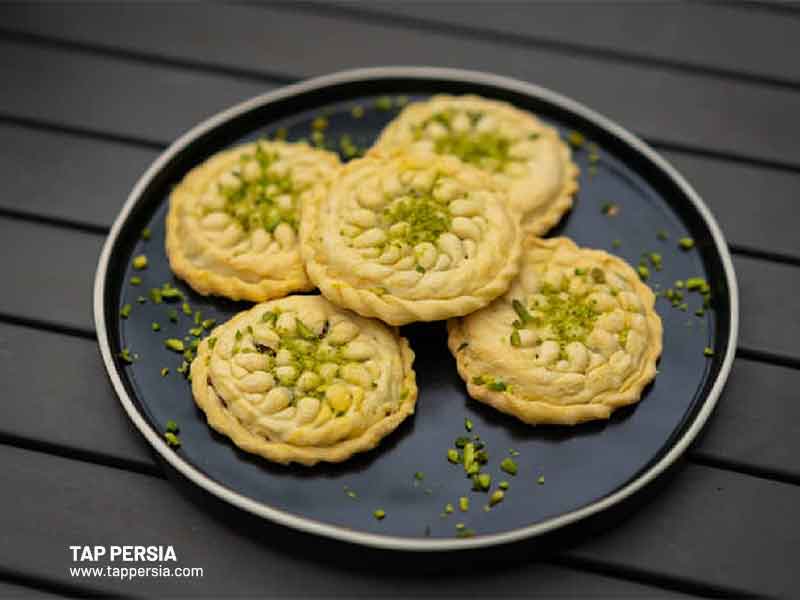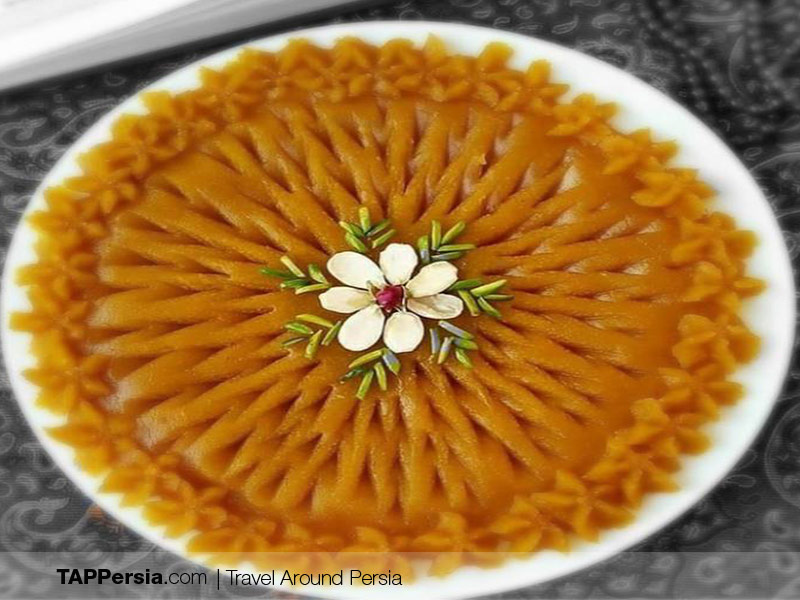The southeast Iranian province of Kerman is well-known for its varied and delicious food in addition to its fascinating history and breathtaking scenery. Aromatic herbs, savory spices and the use of locally obtained ingredients are characteristics of Kerman’s cuisine.
Kerman’s cuisine captures the spirit of its culture and customs with its flavorful rice dishes, rich stews and exquisite sweets. Stay with us so that we can introduce you to all kinds of local food in Kerman, so that you can arrange a trip to this amazing part of Iran.
The Essence of Kerman’s Cuisine: Zireh Polo and More
Explore the essence of Kerman’s cuisine, which combines flavors from Central Asia, the Arab world, and Persia to provide a mouthwatering gastronomic experience.
Every meal highlights the region’s rich cultural legacy and careful attention to flavor, from the fragrant and saffron-infused Zireh Polo to the filling and savory Ash-e Kermani.
Kerman’s food is a celebration of flavor, tradition, and the skill of making mouthwatering culinary masterpieces, with a symphony of spices, fresh ingredients, and traditional cooking techniques.
Zireh Polo: A Kermani Specialty

Zireh Polo (Cumin Rice) is a favorite Kerman food that entices with its rich flavors and enticing scent. The base of this aromatic rice dish is basmati rice that has been infused with a mixture of cumin seeds, saffron, and other aromatic spices.
The meal is elevated to new heights for meat lovers by the addition of delicate lamb or luscious roasted chicken, but vegans may also savor the flavorful rice on its own. Zireh Polo is typically served with creamy yogurt, which provides a refreshing contrast to the aromatic and warm rice. A variety of pickles and fresh herbs are served alongside it to further improve the eating experience and add a bright and energizing touch to each bite.
Ash-e Kermani: The Comforting Soup
In Kerman’s cuisine, there is a particular place for the hearty and filling soup known as Ash-e Kermani. This Kerman food is a blend of legumes, including chickpeas and lentils, as well as a variety of fresh herbs, vegetables, and occasionally delicate meat, go into making this substantial and thick soup.
The components are slowly cooked together to allow the flavors to combine and produce a deep, delicious broth. After the soup is cooked, it is delicately topped with a sprinkling of crispy sautéed onions, aromatic mint leaves, and a crisp squeeze of lemon juice, which gives the soup a zesty twist.
Not only is Ash-e Kermani a wonderful soup, but it’s also a hearty, filling meal that warms the body and the spirit. It is a cherished mainstay of Kerman’s culinary traditions due to its healthy ingredients and soothing flavors.
Kerman’s Signature Dishes
Experience the distinct flavors of the area’s culinary heritage with each of Kerman’s distinctive dishes as you go on a culinary voyage. These well-prepared and historically entrenched meals perfectly capture the spirit of Kerman’s cuisine. Savor the legacy and culinary skill that go into creating these hallmark dishes—a veritable sensory overload—with each bite.
Kermani Abgoosht: A Hearty Stew
Abgooshts are also among the most traditional dishes of Iran. Common abgooshts that we all know are served in all Iranian cities. In addition to them, many Iranian cities have abgooshts that are cooked in the special style of the people of that city.
Read more: Iran tour
Some types of abgoosht of Kerman are shared with other cities, and some others are considered local dishes of Kerman. Some of the most famous Kermani abgooshts are Boz Ghormeh abgoosht, Kashk Badenjan abgoosht and Montanjeneh abgoosht. These flavorful and hearty dishes showcase the culinary expertise of Kerman’s people and offer a taste of the region’s distinct flavors and traditions.
This article will introduce you to 40 of Iran’s most popular local dishes by exploring our detailed guide to Iran’s popular foods
Kaleh Joosh: A Timeless Delight

One of the traditional, well-known, and beloved Iranian foods that is present on the tables of the majority of Iranian households is kale josh. The components of this straightforward meal, which is also prepared in Kerman, include grated curd, tomatoes, dried veggies, mint, and sautéed onions and garlic.
In certain recipes, walnuts are added to kermani cooked head together with bread, dates, and black horseradish. The well-known and cherished dish Kaleh Joosh, which combines creamy curd, tart tomatoes, and fragrant herbs, is a symbol of Kerman’s rich culinary history.
Kerman’s Unique Stews: A Blend of Flavors
Kerman’s cuisine is well known for its distinctive stews, which highlight a tasteful fusion of flavors. Tender meat, flavorful spices, and an array of other ingredients come together in these filling recipes to create a symphony of flavors.
Kerman’s stews provide a delicious exploration of diverse flavors, from the acidic and fragrant Khoresht-e Aloocheh with its sour plum-infused broth to the sweet and sour notes of Khoresht-e Beh Aloo, incorporating quince and spices.
Khoresht-e Beh Aloo: A Sweet and Sour Experience

Khoresht- Beh Aloo, or “Quince and Plum Stew” is a local Kerman food that is considered a seasonal stew; because in its preparation, it is used as an autumn fruit. Of course, you can keep it frozen in the freezer so that you can cook this stew at any time of the year.
This stew is one of the most popular foods in Ramadan, especially for people who suffer from intestinal issues and constipation. This Kerman food is made with meat or thigh marrow, hot onion, liquid oil, sugar, lemon juice (preferably fresh lemon juice), saffron, salt, pepper, turmeric, and Bukhara plum, and it has a soft and delicious taste. Plum stew is served with rice and we recommend you to try it once.
Khoresht-e Aloocheh: The Tart Stew

You will definitely like Khoresht-e Aloocheh’s flavor if you prefer sour and mild flavors and don’t mind having plums or greengage in your cuisine. In Kerman’s formal events and get-togethers, this delicious and wonderful meal is a staple.
Mutton, pinto beans, paste, dried veggies, onions, plums, lemon juice, spices, and either plums or greengage are used to make this stew. The plum adds a high nutritional value to this Kerman food. This makes it a great source of calcium, vitamin D, and boron, all of which can aid in the prevention of osteoporosis and the relief of constipation.
Vegetarian Delights in Kerman Cuisine
While Kerman’s food is known for its rich meat-based dishes, it also offers a delightful array of vegetarian delights that cater to diverse palates.
Whether you’re a vegetarian or simply seeking a lighter option, Kerman’s vegetarian delights will leave you satisfied and impressed with the creativity and depth of its meat-free offerings. These vegetarian dishes highlight the region’s abundant produce and skillful use of herbs and spices.
Kashk-e Kadoo: A Vegetarian’s Choice

Kashk-e Kadoo is one of the local and famous Kerman food, which is made with curd, zucchini, sautéed onion, sautéed garlic, sautéed mint, tomato fillet, walnut kernel powder, salt, pepper, turmeric and oil, and it has a very delicious taste. Kashk-e Kadoo is very similar to Kashk-e Badenjoon (Eggplant Curd); with the difference that it is made with zucchini instead of eggplants.
Due to its low calories, this food is very suitable for the diet and the zucchini can be steamed instead of fried. Zucchini is rich in vitamin C and lutein and helps protect the eyes, prevent lung cancer and prevent osteoporosis.
Kerman’s Street Foods and Snacks
A delectable selection of street meals and snacks that highlight the area’s thriving culinary industry can be found throughout Kerman’s busy streets. A fast and tasty sample of Kerman’s culinary wonders may be had from these street delicacies, which range from savory bites to sweet desserts.
Kebab Zargari: A Street Food Staple

Zargari kebab is another Kerman food, which is very similar to Kabab Tabei (Pan Kebab); But the cooking method and steps are a little different. To cook this dish, they usually fry minced meat in oil and then add hot onions, tomato paste and fried potatoes to it.
While some Kermanis prefer to serve Zargari kebab with rice, such as Zireh Polo (cumin rice), the choice ultimately depends on personal taste. However, the traditional way of enjoying this dish is by pairing it with the quintessential Iranian bread, creating a delightful combination of flavors and textures.
Gipa Kermani: A Delicacy for the Daring
Gipa Kermani holds a special place among the local dishes of Kerman province, often reserved for formal gatherings due to the esteemed status of this Kerman food. This noble food boasts a combination of flavors that will pleasantly surprise your taste buds.
Tripe, split peas, rice, cumin, minced meat, saffron, and sautéed onions come together to create the delicious ensemble of Gipa Kermani. The cooking method, although simple, requires patience as the sheep rumen needs to be simmered for a minimum of 4 hours to ensure it is fully cooked and tender. The result is a dish that showcases the rich culinary heritage of Kerman with its unique blend of textures and aromatic flavors.
Sweet Endings: Kerman’s Desserts

Kerman’s desserts are the perfect conclusion to a memorable culinary journey. These sweet treats showcase the region’s mastery of creating indulgent desserts that delight the senses. Indulge in a slice of Kermani Cake, a moist and fragrant almond-based cake infused with rosewater and cardamom, or savor the delicate sweetness of Kolompeh, a pastry filled with dates and aromatic spices.
For a refreshing dessert, try Faloodeh, a traditional Persian frozen dessert made with thin vermicelli noodles and rosewater syrup. Kerman’s desserts are a celebration of flavors and textures, offering a sweet ending that will leave you with a lingering appreciation for the region’s culinary prowess.
Traditional Sweets and Desserts
Here are just some of the Kermani desserts you can get to enjoy on your fascinating trip:
Kolompeh

One popular dessert is Kolompeh, a pastry filled with a mixture of dates, nuts, and aromatic spices. These bite-sized delights are often enjoyed with a cup of tea or coffee, making them the perfect accompaniment to a leisurely afternoon.
Baqlava(Qottab)
Another beloved sweet treat is Baqlava, a rich and sweet pastry made with layers of flaky filo dough, nuts, and syrup. The combination of textures and flavors in Baqlava creates a truly indulgent experience that is hard to resist.
Bastani Kermani (Kermani Ice Cream)
Kerman is also known for its saffron-infused ice cream, known as Bastani Kermani. This creamy and aromatic treat is made with a blend of milk, saffron, rosewater, and pistachios, resulting in a unique and refreshing dessert that captivates the senses.
Halva Pistachio
One of the treats that provides you a delightful experience is halva pistachio. Flour, sugar, butter, cardamom, rosewater, pistachio powder and saffron are the ingredients of this delectable dessert. Pistachios are also used in confections as they are so common in Kerman.
Ghovatou
Produced in the towns of Zarand, Rafsanjan, Ravar, Bam, Sirjan and Kerman, Ghovatou, also known as Ghaout, is one of the famous souvenirs of the province of Kerman with a long history. This is due to the fact that it is an energy source. The plant Ghovatou, also known as Ghaout of Kerman, is a boosting herb. The edible powder or solution known as Ghovatou is consumed with tea or milk.
Kachi

One of the most traditional and ancient sweets, Kachi is prepared in Iran with a few modifications and has a very soft and delicate texture. This delectable Iranian treat may be found on the table of happiness and joy. Flour, sugar, butter, oil, saffron, rose water, and butter are the ingredients of Kachi. In the past, a lot of animal oil was used to cook Kachi. Rice flour may also be used to make Kachi.




Comment (0)